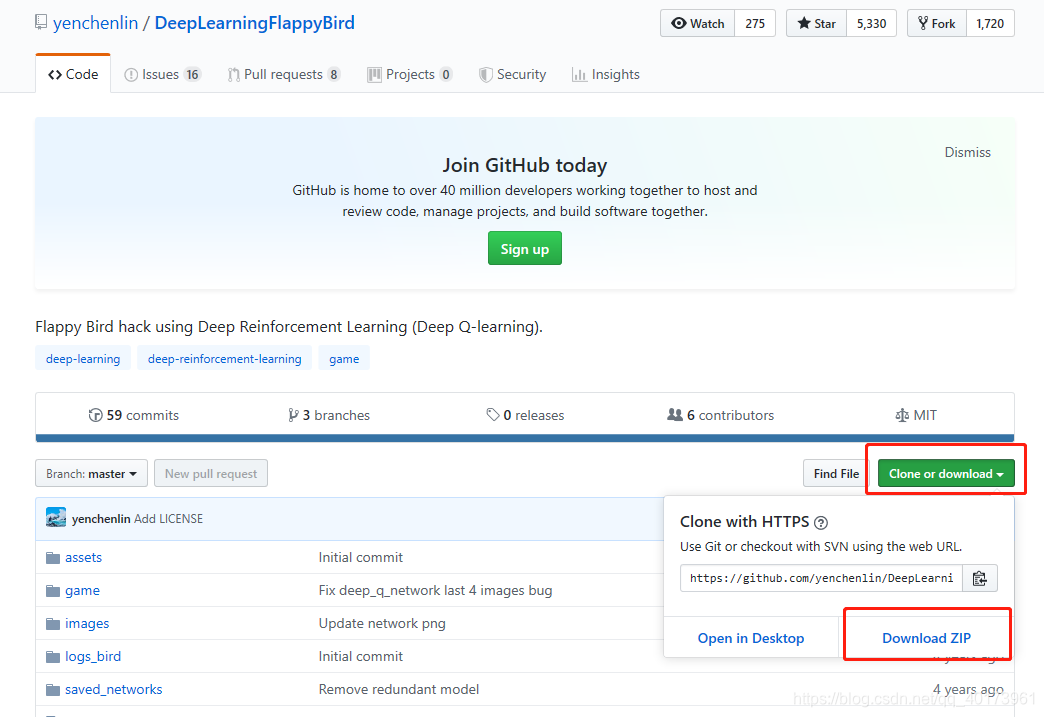深度学习实例——Flappy Bird
安装完之后找了一个实例来测试,目前进展是已经跑通了,但是还没有搞懂细节的部分。先记录一下实现的过程。代码附在文末,先说一下遇到的问题和解决的方法。1.模块导入我使用的编译器是Spyder (tensorflow),按照之前的方法,安装好tensorflow和opencv后,导入这两个模块已经没有问题了。重点说一下这句:sys.path.append("D:/Pytho...
安装完之后找了一个实例来测试,目前进展是已经跑通了,但是还没有搞懂细节的部分。
先记录一下实现的过程。
代码附在文末,先说一下遇到的问题和解决的方法。
1.模块导入
我使用的编译器是Spyder (tensorflow),按照之前的方法,安装好tensorflow和opencv后,导入这两个模块已经没有问题了。
重点说一下这句:
sys.path.append("D:/Python/DeepLearningFlappyBird-master/game/")
这个路径要改成文件相对应的路径,否则会出现报错:
ModuleNotFoundError: No module named 'wrapped_flappy_bird as game'

2.依赖文件
运行的时候用到了一个改进过的flappy bird的代码,文件名是“DeepLearningFlappyBird-master”,下载链接是:https://github.com/yenchenlin/DeepLearningFlappyBird

下载好压缩包,解压后把代码中的相应路径修改,就可以顺利运行了。

3.运行效果
没有GPU加速,实验室的渣渣电脑,配置如下:

运行了有两天了吧,就挂在那里,该干啥干啥,第一天的时候,这只小鸟能过大概十个柱子,现在至少二十个是没问题了(飞得太慢了不想数了)。

嗯,就记录到这了,等哪天搞得明明白白了再回来更新一波~
#!/usr/bin/env python
from __future__ import print_function
import tensorflow as tf
import cv2
import sys
sys.path.append("D:/Python/DeepLearningFlappyBird-master/game/")
import wrapped_flappy_bird as game
import random
import numpy as np
from collections import deque
GAME = 'bird'
ACTIONS = 2
GAMMA = 0.99
OBSERVE = 10000.
EXPLORE = 3000000.
FINAL_EPSILON = 0.0001
INITIAL_EPSILON = 0.0001
REPLAY_MEMORY = 50000
BATCH = 32
FRAME_PER_ACTION = 1
def weight_variable(shape):
initial = tf.truncated_normal(shape, stddev = 0.01)
return tf.Variable(initial)
def bias_variable(shape):
initial = tf.constant(0.01, shape = shape)
return tf.Variable(initial)
def conv2d(x, W, stride):
return tf.nn.conv2d(x, W, strides = [1, stride, stride, 1], padding = "SAME")
def max_pool_2x2(x):
return tf.nn.max_pool(x, ksize = [1, 2, 2, 1], strides = [1, 2, 2, 1], padding = "SAME")
def createNetwork():
#定义深度神经网络的参数和偏置
W_conv1 = weight_variable([8, 8, 4, 32])
b_conv1 = bias_variable([32])
W_conv2 = weight_variable([4, 4, 32, 64])
b_conv2 = bias_variable([64])
W_conv3 = weight_variable([3, 3, 64, 64])
b_conv3 = bias_variable([64])
W_fc1 = weight_variable([1600, 512])
b_fc1 = bias_variable([512])
W_fc2 = weight_variable([512, ACTIONS])
b_fc2 = bias_variable([ACTIONS])
# 输入层
s = tf.placeholder("float", [None, 80, 80, 4])
# 隐藏层
h_conv1 = tf.nn.relu(conv2d(s, W_conv1, 4) + b_conv1)
h_pool1 = max_pool_2x2(h_conv1)
h_conv2 = tf.nn.relu(conv2d(h_pool1, W_conv2, 2) + b_conv2)
h_conv3 = tf.nn.relu(conv2d(h_conv2, W_conv3, 1) + b_conv3)
h_conv3_flat = tf.reshape(h_conv3, [-1, 1600])
h_fc1 = tf.nn.relu(tf.matmul(h_conv3_flat, W_fc1) + b_fc1)
# 输出层
readout = tf.matmul(h_fc1, W_fc2) + b_fc2
return s, readout, h_fc1
def trainNetwork(s, readout, h_fc1, sess):
# 定义损失函数
a = tf.placeholder("float", [None, ACTIONS])
y = tf.placeholder("float", [None])
readout_action = tf.reduce_sum(tf.multiply(readout, a),
reduction_indices=1)
cost = tf.reduce_mean(tf.square(y - readout_action))
train_step = tf.train.AdamOptimizer(1e-6).minimize(cost)
# 开启游戏模拟器,会打开一个模拟器的窗口,实时显示游戏的信息
game_state = game.GameState()
# 创建双端队列用于存放replay memory
D = deque()
# 获取游戏的初始状态,设置动作为不执行跳跃,并将初始状态修改成80*80*4大小
do_nothing = np.zeros(ACTIONS)
do_nothing[0] = 1
x_t, r_0, terminal = game_state.frame_step(do_nothing)
x_t = cv2.cvtColor(cv2.resize(x_t, (80, 80)), cv2.COLOR_BGR2GRAY)
ret, x_t = cv2.threshold(x_t,1,255,cv2.THRESH_BINARY)
s_t = np.stack((x_t, x_t, x_t, x_t), axis=2)
# 用于加载或保存网络参数
saver = tf.train.Saver()
sess.run(tf.initialize_all_variables())
checkpoint = tf.train.get_checkpoint_state("saved_networks")
if checkpoint and checkpoint.model_checkpoint_path:
saver.restore(sess, checkpoint.model_checkpoint_path)
print("Successfully loaded:", checkpoint.model_checkpoint_path)
else:
print("Could not find old network weights")
# 开始训练
epsilon = INITIAL_EPSILON
t = 0
while "flappy bird" != "angry bird":
# 使用epsilon贪心策略选择一个动作
readout_t = readout.eval(feed_dict={s : [s_t]})[0]
a_t = np.zeros([ACTIONS])
action_index = 0
if t % FRAME_PER_ACTION == 0:
# 执行一个随机动作
if random.random() <= epsilon:
print("----------Random Action----------")
action_index = random.randrange(ACTIONS)
a_t[random.randrange(ACTIONS)] = 1
# 由神经网络计算的Q(s,a)值选择对应的动作
else:
action_index = np.argmax(readout_t)
a_t[action_index] = 1
else:
a_t[0] = 1 # 不执行跳跃动作
# 随游戏的进行,不断降低epsilon,减少随机动作
if epsilon > FINAL_EPSILON and t > OBSERVE:
epsilon -= (INITIAL_EPSILON - FINAL_EPSILON) / EXPLORE
# 执行选择的动作,并获得下一状态及回报
x_t1_colored, r_t, terminal = game_state.frame_step(a_t)
x_t1 = cv2.cvtColor(cv2.resize(x_t1_colored, (80, 80)),
cv2.COLOR_BGR2GRAY)
ret, x_t1 = cv2.threshold(x_t1, 1, 255, cv2.THRESH_BINARY)
x_t1 = np.reshape(x_t1, (80, 80, 1))
s_t1 = np.append(x_t1, s_t[:, :, :3], axis=2)
# 将状态转移过程存储到D中,用于更新参数时采样
D.append((s_t, a_t, r_t, s_t1, terminal))
if len(D) > REPLAY_MEMORY:
D.popleft()
# 过了观察期,才会进行网络参数的更新
if t > OBSERVE:
# 从D中随机采样,用于参数更新
minibatch = random.sample(D, BATCH)
# 分别将当前状态、采取的动作、获得的回报、下一状态分组存放
s_j_batch = [d[0] for d in minibatch]
a_batch = [d[1] for d in minibatch]
r_batch = [d[2] for d in minibatch]
s_j1_batch = [d[3] for d in minibatch]
#计算Q(s,a)的新值
y_batch = []
readout_j1_batch = readout.eval(feed_dict = {s : s_j1_batch})
for i in range(0, len(minibatch)):
terminal = minibatch[i][4]
# 如果游戏结束,则只有反馈值
if terminal:
y_batch.append(r_batch[i])
else:
y_batch.append(r_batch[i] +
GAMMA * np.max(readout_j1_batch[i]))
# 使用梯度下降更新网络参数
train_step.run(feed_dict = {
y : y_batch,
a : a_batch,
s : s_j_batch}
)
# 状态发生改变,用于下次循环
s_t = s_t1
t += 1
# 每进行10000次迭代,保留一下网络参数
if t % 10000 == 0:
saver.save(sess, 'saved_networks/' + GAME + '-dqn', global_step=t)
# 打印游戏信息
state = ""
if t <= OBSERVE:
state = "observe"
elif t > OBSERVE and t <= OBSERVE + EXPLORE:
state = "explore"
else:
state = "train"
print("TIMESTEP", t, "/ STATE", state, \
"/ EPSILON", epsilon, "/ ACTION", action_index, "/ REWARD", r_t, \
"/ Q_MAX %e" % np.max(readout_t))
def playGame():
sess = tf.InteractiveSession()
s, readout, h_fc1 = createNetwork()
trainNetwork(s, readout, h_fc1, sess)
if __name__ == "__main__":
playGame()
更多推荐
 已为社区贡献1条内容
已为社区贡献1条内容











所有评论(0)